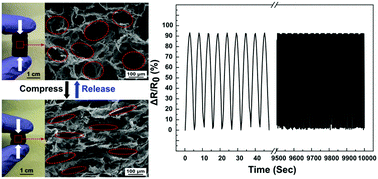Three-dimensional and ultralight sponges with tunable conductivity assembled from electrospun nanofibers for a highly sensitive tactile pressure sensor†
Abstract
This work outlines a general method to prepare a three-dimensional (3D), highly porous, and conductive sponge with tunable conductivity for a tactile pressure sensor. The 3D conductive sponge is prepared by the assembly of shortened/fragmented electrospun nanofibers of polyacrylonitrile (PAN), polyimide (PI), and PAN-based carbon. The nanofibers of PAN, PI, and carbon are dispersed in water/ethanol with polyvinyl alcohol (PVA) and then freeze dried to form the 3D conductive sponge. Subsequently, the sponge is thermally treated at 230 °C; and the dehydrated PVA acts as a binder to uniformly bond electrospun carbon nanofibers (CNFs) on the mechanically resilient 3D scaffold of PAN/PI. Upon varying the amounts of CNFs, the resistance of the 3D nanofibrous sponge is readily tailored from ∼260 kΩ to ∼200 Ω. The resistance change of the 3D conductive sponge under cyclic compressive strain is investigated, and the results are correlated with the unique interconnected and hierarchically structured pores in the sponge. A tactile pressure sensor array composed of 25 devices of conductive sponges is demonstrated.



 Please wait while we load your content...
Please wait while we load your content...